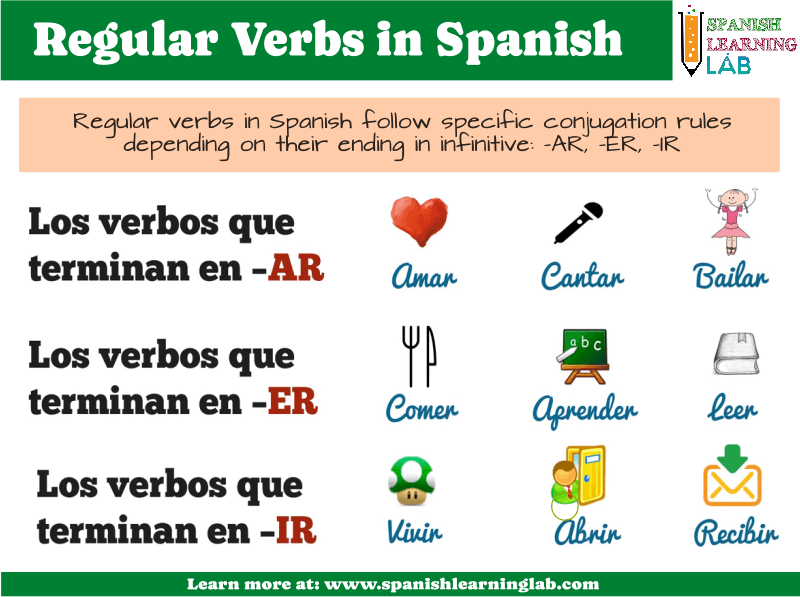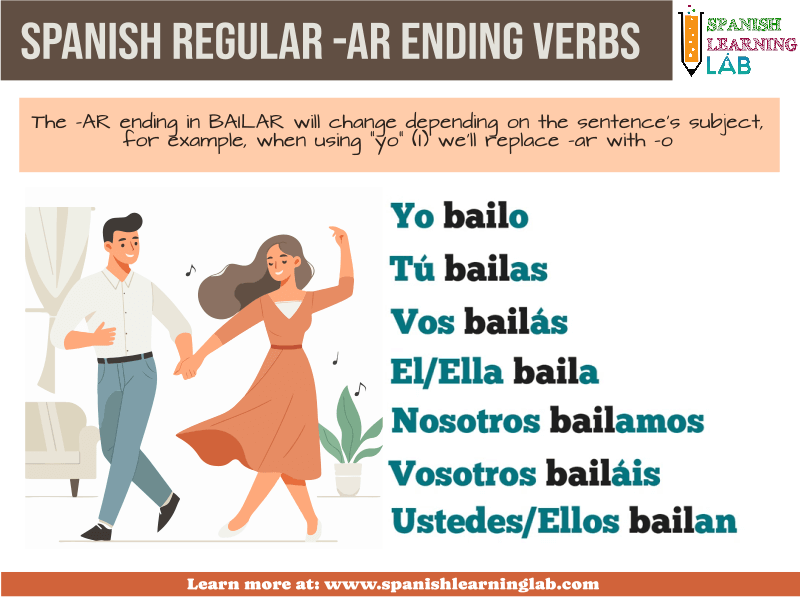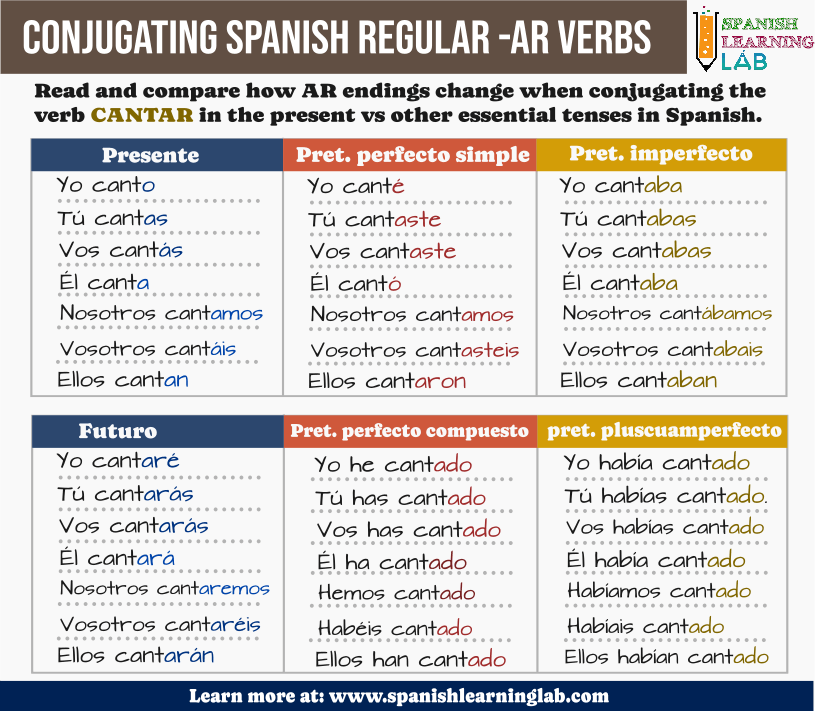Thank you for visiting our site! In this lesson, you will learn more about the rules to conjugate regular verbs ending in -AR, both in the simple present tense and in other tenses too. We have added many examples and exercises so that you can test your understanding of this topic. Let’s get started…
What are regular verbs in Spanish?
Regular verbs are those that follow specific conjugation rules for each tense depending on their original form, particularly their endings (-AR, -ER, -IR), traditionally represented by the verbs amar (to love), temer (to fear), and partir (to leave). Take a look at this image showing some very common regular verbs in Spanish:

Regular verbs ending in -AR in the present tense
As shown in the image above, the verbs AMAR (to love), CANTAR (sing), and BAILAR (dance) are examples of commonly used regular verbs ending in AR. Keep in mind that not all verbs ending in AR are regular, so you should memorize which ones are regular in order to apply the conjugation rules appropriately. To conjugate them, you will need to replace the -AR ending with another that agrees with the subject of the sentence, as shown in this image with the verb BAILAR (dance) below:

There are many regular verbs that end in -AR in Spanish, and if they are used in the present indicative, we would have to follow the rules in the image above. This way, we could follow the same pattern to conjugate verbs like COMER (to sing) and SALTAR (to jump):
- CANTAR: Yo canto, tú cantas, él canta, nosotros cantamos, vosotros cantáis, ellos cantan
- SALTAR: Yo salto, tú saltas, él salta, nosotros saltamos, vosotros saltáis, ellos saltan
The following image shows a list of very common verbs ending in -AR and the conjugation pattern we must follow to conjugate them.

Interactive quiz No. 1
Complete the conjugations for these AR ending regular verbs and check your answers in the interactive quiz.
Forming sentences with regular verbs in Spanish
To form basic sentences with Spanish regular verbs, we will need a subject, which could be a personal pronoun or the name of an object. Then, we will add the correct conjugation for that subject and finally a complement if necessary. It’s not strictly necessary to add the subject to the sentences, but it is important to conjugate the verb appropriately, even if it’s not mentioned, for example:
- Nosotros escuchamos nuestra música favorita. (We added “nosotros”, but we can omit it in the sentence.)
- Escuchamos nuestra música favorita.
Read and listen to the following group of sentences using some of the regular verbs ending in AR in the images:
|
HABLAR: Yo hablo con mis padres todos los días.
TALK: I talk to my parents every day.
|
|
CANTAR: Tú cantas como un profesional.
SING: You sing like a pro.
|
|
PLANEAR: La maestra planea clases muy entretenidas.
PLAN: The teacher plans very entertaining classes.
|
|
VIAJAR: Pedro viaja a todas partes porque él es actor.
TRAVEL: Pedro travels everywhere because he is an actor.
|
|
CAMINAR: Vos caminás por el parque todas las tardes.
WALK: You walk through the park every afternoon.
|
|
TRABAJAR: Nosotros trabajamos en la misma compañía.
WORK: We work in the same company
|
|
BAÑAR: ¿Vosotros os bañáis todos los días?
BATHE: Do you take a shower every day?
|
|
ESTUDIAR: Ustedes estudian mucho para dominar el idioma.
STUDY: You study hard to master the language.
|
| TOCAR: Yo toco el piano en mi tiempo libre.. We will analyze the reports and make a decision tomorrow. |
|
LUCHAR: Ellos luchan por mejores condiciones laborales.
FIGHT: They fight for better working conditions.
|
Interactive quiz No. 2
Complete these sentences with the correct forms of the regular verbs ending in AR in parentheses.
Spanish Regular -AR ending verbs in other tenses
Just as in the present tense, regular verbs ending in -AR also follow grammatical rules in other tenses, such as the simple past, the imperfect preterite, the simple future, the Spanish present perfect, and the past perfect. These ending changes are predictable in some cases, but just as in the present tense, we must memorize these endings to apply them correctly to all regular verbs. Pay attention to this image, which includes six different but essential tenses in Spanish, and watch carefully how these verbs are conjugated correctly for each tense.

Here are some examples of sentences with -Ar regular verbs in some of the tenses in the picture above.
|
CUIDAR: Yo cuidé a los niños anoche.
TO TAKE CARE OF: I took care of the children last night.
|
|
ESTUDIAR: Nosotros estudiamos como locos para la prueba.
STUDY: We studied like crazy for the test.
|
|
AMAR: Ellos amaban las caricaturas y las historietas.
LOVE: They loved cartoons and comics.
|
|
TROTAR: El caballo trotaba lento, pero de forma elegante.
TROT: The horse trotted slowly, but elegantly.
|
|
ABRAZAR: Yo abrazaré fuertemente a los niños cuando regresen.
HUG: I will hug the children tightly when they return.
|
|
ENTRENAR: Nosotros entrenaremos mucho para ganar la competencia.
TRAIN: We will train hard to win the competition.
|
|
AYUDAR: Vosotros habéis ayudado mucho el día de hoy.
HELP: You have really helped out a lot today!
|
|
APUNTAR: Los chicos han apuntado correctamente al objetivo.
AIM: The boys have correctly aimed at the target.
|
|
TERMINAR: Isabel había terminado su turno cuando su jefe llegó.
FINISH: Isabel had finished her shift when her boss arrived.
|
|
COMENZAR: Tú habías comenzado antes de que sonara el silbato.
START: You had started before the whistle blew.
|
Interactive quiz No. 3
Drag the verb conjugations to the correct spaces to complete these sentences.
Practice more with these PDF worksheets:
- Conjugating -AR Regular Verbs in Spanish (Present)
- Spanish Regular -AR Verbs in the Present Tense – PDF Worksheet
- Spanish Verbs Conjugation (Present Tense) – PDF Worksheet
